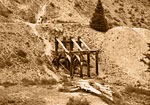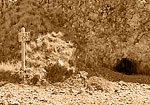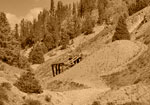

Oro Fino
Denmark
Deldosso
Silver Queen
Enderman



![]()
![]()
![]()
In 1894, gold was discovered by Ira Wing along Comanche Creek in today's Valle Vidal unit of the Carson National Forest. At the time the area was part of the Costilla Estate of the Sangre de Cristo Land Grant and was owned by a Dutch company, operating as the U. S. Freehold Land and Emigration Co. Within a year of the discovery, hundreds of miners and prospectors flooded the valley and as a result, the town of La Belle came into being. Mining claims were staked over a wide area and mines were opened, necessitating the formation of the Keystone Mining District.
Since this district was located on private property ( the Freehold Land and Emigration Co.), there were extra fees and costs for establishing a mining claim. As a result, a number of prospectors travelled westward a few miles, crossed a ridge, and came down into Bitter Creek. This was located on U. S. government land which was open to homesteading and here the claims filing costs were significantly less. Near the headwaters of Bitter Creek a number of cabins were built, several mines were opened and the town of Anchor was established in 1895. In that same year the Edison mine was opened adjacent to the town and east of the creek.
The production was somewhat uneven, varying from thirty to a thousand dollars of gold per ton of ore. Because of the continued presence of the richer ore, the owners became optimistic and in 1898 decided to order a ten-stamp mill from Denver. While awaiting shipment of the equipment, the mill site was prepared and all the necessary construction was completed. The following year the mill began actual work under the direction of superintendent L. E. Pennock. Initial results were encouraging but over time the quality of the ore became less, so that the value of the mill production barely covered expenses. This was aggravated by the fact that the mine tunnel was located only slightly above the level of the creek and thus, water in the mine was an ongoing problem. As a result of all the difficulties, the mill and mine work was gradually cut back and finally the mine was shut down.
In 1910 there was a general revival of gold mining in the Red River area, brought about by some new discoveries, improved economic conditions throughout the region, and better methods of extracting the gold. A number of mines were reopened and this included the Edison. However, the mill production was once again disappointing and only managed to cover expenses. Therefore after operating a couple of years the Edison mine was closed once again.
In the early 1930s, an Englishman appeared in Albuquerque with some rich ore which he claimed had come from the Edison mine. This created considerable interest and he was able to raise a sizable amount of investment money. He then hired Jack Brandenburg of Red River to drain and clean up the mine. When the job was finished, Brandenburg presented his bill, but the Englishman stalled. An attorney was able to collect the money but the remainder of the investment money disappeared along with the mine promoter.

Edison Mill

Edison Buildings

Edison Framework

Mill Remains

Edison Shaft

Area around Edison

